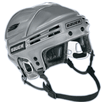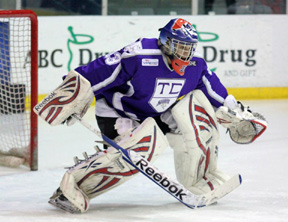The Helmet
“Rule #22b – All players of both teams shall wear
a helmet of design, material and construction approved by the Rules
Committee at all times while participating in a game, either on the playing
surface or the players’ bench or the penalty benches.”
During the 1970’s wearing a helmet became mandatory in junior and college
hockey. It was mandatory for every NHL player who signed a contract after
June 1, 1979. Wearing the helmet was voluntary for any player who was a
member of the NHL before that. The last player to go bareheaded was Craig
MacTavish (St. Louis Blues) in the 1995-6 season. He retired after the
following season.
Before
the 1970’s a few NHL players wore helmets. Usually it was because they were
recovering from a head injury. One player wore his because he had a metal
plate in his head. In the case of one Blackhawk player it was because he was
embarrassed about being bald.
If a goalie’s or a player’s helmet comes off during play, a linesman or the
ref is to stop the play immediately. In the case of the player, he has to
leave the ice and cannot come back on until after the face-off. If either
the goalie or a player causes a stoppage in play by deliberately removing
his helmet, he gets a 2-minute penalty.
All players must wear their helmets with the chin straps properly fastened.
If they remove the helmet while on the ice, on the bench, or in the penalty
box, and are warned by the ref to put it back on but do not, they can also
receive a 2-minute penalty.
There is an organization called the HECC (Hockey Equipment Certification
Council) whose mission is “to seek out, evaluate and select standards and
testing procedures for hockey equipment for the purpose of safety
certification.”
They have
lists of approved hockey equipment which can be found on their website
<hecc.net>. Nike Bauer is probably the most familiar brand name on the list.
Helmets are made of a resin
or plastic called vinyl nitrile. This material will absorb the impact of a
stick, a puck, skates, or the blow of hitting the ice. The inside is
reinforced with an Aramid fiber. Aramid is short for "aromatic polyamide".
It is a strong, heat-resistant fiber. Kevlor and Twaron are two brand names
for this material. While the helmet is not guaranteed to prevent
concussions, wearing it reduces the danger.

hecc.net
Hockey for Dummies
Junior Rulebook 2007-9, 304 a & b
The Official Rules for Hockey
Wikipedia
|
|

